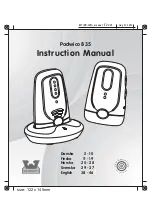
T R O U B L E S H O O T I N G A N D S U P P O R T
261
Example:
You have two TalkSwitch units, six telephone lines and 12 employees. The six
lines have the hunt/rollover service from the phone company. Suggested setup: Plug the
four highest traffic lines into unit 1. Also, connect the eight highest phone usage employee
extensions to unit 1. Connect the remaining lines and extensions to unit 2.
Calls across the LAN are lower in volume
1. Check the
Telephone Lines - Audio
page. You may need to change the transmit level or
impedance matching on one or more lines to compensate for high loss lines. If these
controls are set incorrectly and your lines are problematic, you may hear an echo when calls
are made across the LAN.
VoIP
I hear a re-order tone when I try to dial a VoIP location
1. Confirm the number dialed is actually part of the VoIP group (i.e. registered with the same
proxy/registrar server as your TalkSwitch, IP gateway or IP extension is registered with.
2. Ensure TalkSwitch has all proper settings in the
IP Configuration
and
VoIP
Configuration
pages.
3. Ensure the number you are dialing is registered with your TS proxy registrar. Go to the
VoIP
Configuration
page and click the
View Registrar Entries
button.
Callers complain the sound is distorted or choppy
1. Your broadband connection may not have enough upstream bandwidth to support many
simultaneous VoIP calls.
In the
Codec Options
window, you may need to disable the G.711
and G.726 codecs and only use G.729.
2. You may have too much data traffic on your Internet connection at the same time you are
trying to make voice calls. We suggest you use a router that supports QoS (Quality of
Service) for VoIP.
When I call someone or they call me, voice is only heard in one direction
1. The cause of this problem is usually a result of a router being misconfigured with respect to
port mappings. Ensure all required VoIP ports are mapped to your TalkSwitch unit. Also,
ensure you use a static private IP address when connected to your router as this can also
affect port mappings from the firewall/router.
2. Use a router that supports uPnP.
For more VoIP information, see
VoIP Information
on page 232.
















































